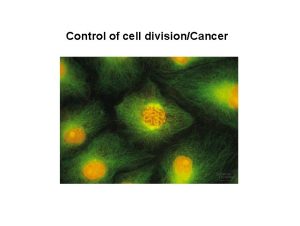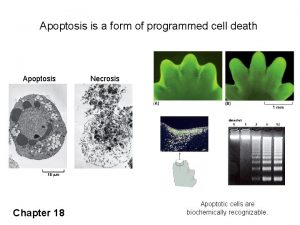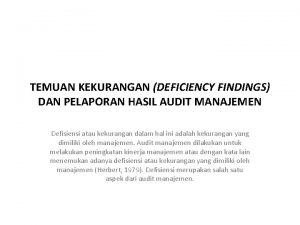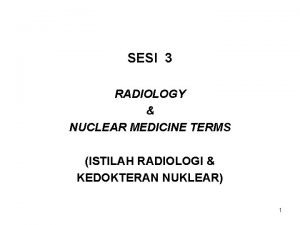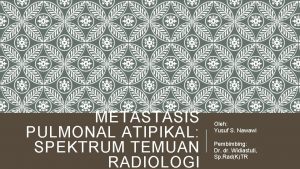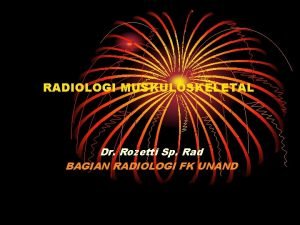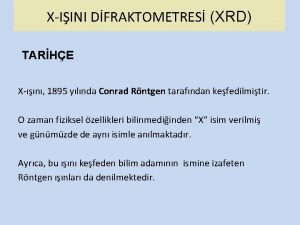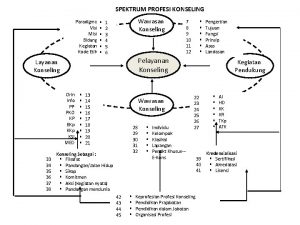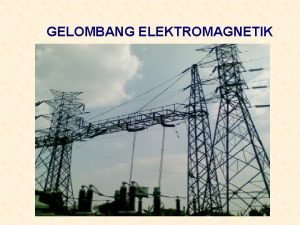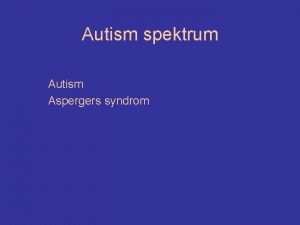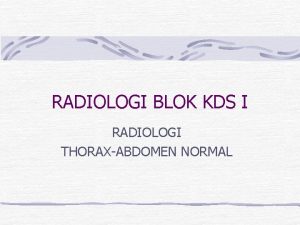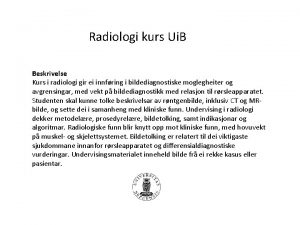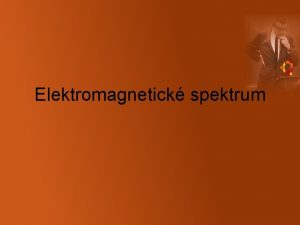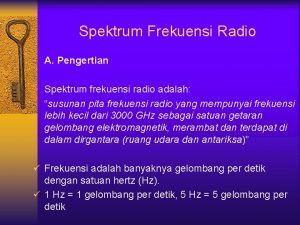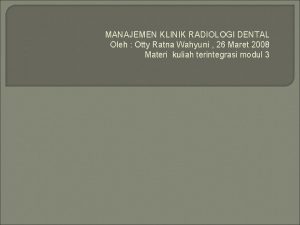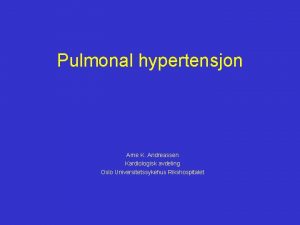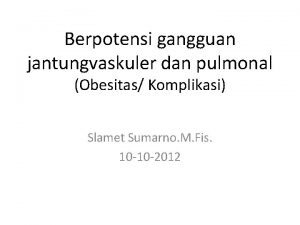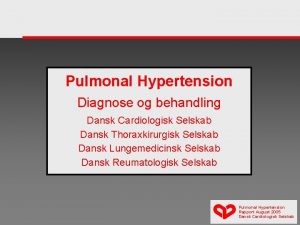METASTASIS PULMONAL ATIPIKAL SPEKTRUM TEMUAN RADIOLOGI Oleh Yusuf



























- Slides: 27

METASTASIS PULMONAL ATIPIKAL: SPEKTRUM TEMUAN RADIOLOGI Oleh: Yusuf S. Nawawi Pembimbing: Dr. dr. Widiastuti, Sp. Rad(K)TR

PENDAHULUAN Paru-paru organ yang menyerupai filter Venous return mengandung cairan limfatik dari jaringan tubuh mengalir ke paru Metastasis paru sangat sering 20%– 54% pasien dengan keganasan meninggal Payudara, colon, ginjal, uterus dan KL Choriocarcinoma, osteosarcoma, testis, melanoma, Ewing’s sarcoma, karsinoma tiroid

PATOGENESIS METASTASIS PARU Mekanisme Arteri pulmonal/bronchial Limfatik Cavum pleura Jalan nafas Invasi langsung Penyebaran hematogen—paling sering Sebagian besar hingga mencapai capillary bed dan arteriol Beberapa bertahan dan tumbuh dalam interstisial

METASTASIS PARU Tipikal metastasis Atipikal metastasis Hematogen Massa dengan kavitasi Nodul ukuran bervariasi, random, multiple Penebalan difus interstisial (limfangitik karsinomatosis) Massa dengan kalsifikasi Pneumotoraks spontan Atenuasi ground-glass sekitar massa (CT halo sign) Konsolidasi dengan atau tanpa groundglass opacity Massa dalam arteri pulmonal Atelektasis, massa endobronchial

KAVITASI Insiden: 4% metastasis; 9% primer 70% berasal dari squamous cell ca; laporan lain menyebut tidak terdapat perbedaan signifikan dengan adenoca Sarkoma metastasis dapat membentuk kavitas, disertai pneumotoraks Kemoterapi menginduksi kavitasi Organ primer yang paling sering Kepala dan leher pada pria Genital pada wanita Mekanisme: Nekrosis jaringan tumor Check-valve mechanism pada infiltrasi tumor pada struktur bronkhial

Figure 1. Cavitating metastasis in a 72 -year-old man with a squamous cell carcinoma in the left main bronchus. Transverse CT scan obtained with lung window settings shows multiple metastatic nodules in both lungs. There are several cavitating nodules (arrows) in both lower lobes. Note the irregular thickening of the cavity walls.

Figure 2. Cavitating metastasis in a 51 -year-old man who had undergone total laryngectomy due to a laryngeal squamous cell carcinoma 2 years previously. (a) Frontal chest radiograph obtained before chemotherapy shows multiple masses (arrows) in both lungs. Note the small eccentric cavitation (arrowhead) of the mass in the left upper lung. (b) Frontal chest radiograph obtained after two cycles of chemotherapy shows extensive cavitation of nodules with air-fluid levels (arrows). Note the irregular thickening of the cavity walls. Sputum cytologic examination revealed squamous cell carcinoma.

Figure 3. Cavitating metastasis in a 28 -year-old man who had undergone resection of the rectum due to an adenocarcinoma 2 years previously. Transverse CT scan of the left lung, obtained with lung window settings, shows multiple areas of nodular attenuation with central cavitations (arrows). The walls of the nodules are relatively thin. Cavitation of the nodules was not seen on the chest radiograph (not shown).

Figure 4. Cavitating metastasis associated with a pneumothorax and hemorrhage from an angiosarcoma of the scalp in an 86 -year-old man who experienced abrupt onset of dyspnea and hemoptysis. (a) Frontal chest radiograph shows bilateral pneumothoraces (arrows) and diffuse reticular attenuation of both lungs. A drainage catheter is seen in the left hemithorax. (b) Transverse thin-section (1. 0 -mm) CT scan shows multiple variable-sized thin-walled cavities and bilateral pneumothoraces. Although most of the cavities appear round, some of them have bizarre shapes, mimicking the cysts of Langerhans cell histiocytosis. A subpleural cavity is ruptured into the pleural space (arrow). Multifocal areas of ground-glass opacity are seen in both lungs. (c) Photograph of the resected specimen shows hemorrhagic nodules (arrows) with central cavitary change. (d) Photomicrograph (original magnification, 400; hematoxylin-eosin stain) reveals the wall of the cavity () is composed of large

KALSIFIKASI Nodul jinak Mekanisme: Granuloma Hamartoma: jarang terjadi Bone formation: osteosarcoma atau chondrosarcoma Kalsifikasi distrofik: ca papillary carcinoma of the thyroid, GCT, synovial sarcoma, tumor metastasis dengan terapi Kalsifikasi mucoid: mucinous adenocarcinoma GI dan payudara Kalsifikasi di metastasis

Figure 5. Calcified metastasis in a 44 -year-old woman who had undergone wide excision of a left thigh mass, which proved to be an osteosarcoma, 7 years previously. (a) Frontal chest radiograph shows multiple areas of nodular attenuation in both lungs. A focal calcification (arrow) is suspected in the nodule in the left upper lobe. (b) Transverse contrast-enhanced CT scan obtained at the level of the aortic arch clearly shows calcification (arrow) within the nodule. Histopathologic examination of the resected mass revealed a metastatic osteosarcoma with the foci of ossification.

PERDARAHAN SEKITAR NODUL METASTASIS CT halo sign TIDAK SPESIFIK Atenuasi nodular dikelilingi ground glass opacity halo Batas tidak tegas Hemorrhagic metastasis nodul: Angiosarcomas Choriocarcinomas Mekanisme: Rapuhnya jaringan neovascular yang memicu rupture pembuluh darah Kondisi patologis lain: Invasive aspergillosis, candidiasis, Wegener granulomatosis, tuberculoma associated with hemoptysis, bronchioloalveolar carcinoma, dan limfoma

Figure 7. Hemorrhagic metastasis in a 42 -year-old woman with a choriocarcinoma who presented with hemoptysis. Her blood –human chorionic gonadotropin level was more than 140, 000 U/m. L. (a) Frontal chest radiograph shows ill-defined nodular and patchy attenuation in both lungs. (b) Transverse CT scan obtained with modified lung window settings shows multiple areas of nodular attenuation with surrounding areas of ground-glass opacity (arrows). The areas of ground-glass opacity are due to hemorrhage around the metastatic nodules. A small cavitation (arrowhead) is seen within the mass in the right lung.

PNEUMOTORAKS Akibat nekrosis tumor Paling sering--osteosarkoma: 5 -7% kasus Mekanisme: nekrosis subpleural metastasis menimbulkan fistula bronchopleural Figure 8. Pneumothorax in a 19 -year-old man with a known osteosarcoma of the lower extremity who suddenly developed dyspnea. Frontal chest radiograph shows a pneumothorax (arrows). Note the multiple small metastatic pulmonary nodules (arrowheads).

Figure 9. Air-space pattern of metastasis from an adenocarcinoma of the stomach in a 38 -year-old man who had undergone radical gastrectomy 4 years previously. (a) Frontal chest radiograph shows air-space consolidation with an air bronchogram in the right upper lobe. A chest radiograph obtained 1 year previously (not shown) revealed small patchy poorly marginated lesions in the right upper lobe that were consistent with tuberculosis and failed to respond to antituberculous therapy. (b) Transverse CT scan shows consolidation in the right upper lobe with surrounding ground-glass opacity and an air bronchogram (arrow). Wedge biopsy of this lesion revealed an adenocarcinoma, which was also the histopathologic finding in the stomach lesion. AIR-SPACE PATTERN Metastasis adenocarcinoma, payudara dan ovarii Penyebaran melalui dinding alveolus yang intak (lepidic growth) ~ bronchioloalveolar carcinoma

TUMOR EMBOLISM • Pada arteri kecil-medium • Diagnostik radiologis sulit • Dilatasi dan beading multifocal arteri subsegmental perifer • Infark: atenuasi area wedge-shaped perifer • Emboli tumor yang besar pada arteri pulmonal utama, lobar atau segmental • Tumor sering terkait dengan emboli pulmonal • Hepatoma, payudara, RCC, gastrik dan prostat dan choriocarcinoma

Figure 10. Massive tumor emboli in a 48 -year-old man who had undergone hepatic segmentectomy because of a hepatocellular carcinoma 2 years previously and who suddenly developed dyspnea. (a) Transverse contrastenhanced CT scan obtained at the subcarinal level shows large thrombi (arrows) in the right main and left descending interlobar artery. The thrombi are thought to have originated from the tumor in the inferior vena cava. (b) Transverse CT scan obtained with lung window settings through the lung bases shows multifocal areas of peripheral wedge-shaped consolidation and ground-glass opacity that are thought to be pulmonary infarction. Subsegmental arteries (arrows) have a dilated and beaded appearance. Because they were not seen on CT scans obtained with lung window settings through the same level 5 days earlier (not shown), associated areas of nodular attenuation (arrowheads) within the areas of ground-glass opacity are thought to be dilated small arteries or arterioles filled with tumor emboli rather than hematogenous metastatic nodules. (c) Transverse contrast-enhanced abdominal CT scans obtained 5 days before a and b show a diffuse hepatoma (arrow) in the right hepatic lobe and a surgical defect in segment 8. Tumor thrombi (arrowheads) are also seen in the right hepatic vein and the inferior vena cava. (d) Transverse contrast-enhanced CT scans of the abdomen, obtained with a and b, show that the extent of the hepatic lesion has not changed, but the tumor thrombi in the inferior vena cava (arrowheads) are not seen. The patient died of respiratory failure 20 days later, despite intensive thrombolytic and supportive therapy.

ENDOBRONCHIAL METASTASIS • Jarang • Terjadi pada jalan nafas mayor pada 2% kasus • Rute utama yang mungkin • Langsung pada dinding bronchus • Aspirasi sel tumor • Penyebaran limfatik • Metastasis hematogen pada dinding bronchial • Sel tumor pada limfonodi atau parenkim paru yang berada di sekitar bronchus tumbuh sepanjang bronchial tree lesi intraluminal

Ginjal, payudara, dan kolorektal Tampilan radiologis yang paling sering -- atelectasis lobaris Figure 11. Solitary endobronchial metastasis in a 47 -year-old man who had undergone right nephrectomy because of a renal cell carcinoma 3 years previously. (a) Transverse CT scan shows a solitary pulmonary nodule (arrow) adjacent to the posterior segmental bronchus of the right upper lobe. Mild dilatation of the peripheral bronchi (arrowheads) is also seen. (b) Bronchoscopic image shows an endobronchial mass (arrow) in the posterior segmental bronchus of the right upper lobe. (c) Photomicrograph (original magnification, x 10; hematoxylin-eosin stain) reveals a metastatic tumor ( ) of a renal cell carcinoma invading through the bronchial wall and shows the endobronchial extension (arrow).

Figure 12. Endobronchial metastasis in a 59 -year-old man with renal cell carcinoma who presented with dyspnea. (a) Frontal chest radiograph shows collapse of the left upper lobe with a suggested mass shadow (arrow) in the left hilum. (b) Transverse contrastenhanced CT scan at the carinal level shows an endobronchial mass (arrowhead) in the orifice of the left upper lobar bronchus with collapse of the left upper lobe (arrow). Biopsy of the endobronchial mass and the right renal mass revealed a renal cell carcinoma. (Case courtesy of Jin Hwan Kim, MD, Department of Radiology, Chungnam National University, Taejeon, Korea. )

SOLITARY METASTASIS • Metastasis soliter tanpa riwayat keganasan • CT: 0. 4 -9% • Foto Toraks: 25% • Nodul pulmonal soliter dideteksi pada pasien dengan keganasan ekstrapulmonal • 46% terbukti metastasis • Kecenderungannya bervariasi berdasarkan tipe histologis tumor primer dan usia pasien • Keganasan yang sering: • Melanoma, sarcoma, colon ca, payudara, ginjal, bladder, dan testis

DILATED VESSELS WITHIN A MASS • Dilatasi pembuluh darah • Hipervaskularitas • Sarkoma alveolar soft-part • leiomyosarkoma

Figure 13. Dilated vessels within a metastatic mass in a 32 -year-old woman who had undergone excision of an alveolar soft-part sarcoma of the left foot 5 years previously. (a) Transverse contrast-enhanced CT scan shows a well-defined enhancing nodule in the left lower lobe. Enhancing tubular structures (arrowheads) in the lesion suggest dilated vessels. (b) Photograph of a resected specimen slide (original magnification, X 1; hematoxylin-eosin stain) reveals a well-circumscribed nodule containing a dilated vascular structure (arrow), which corresponds to the enhancing tubular structure seen in a. The black line at the top indicates 1 cm. (Reprinted, with permission, from reference 46. )

STERILIZED METASTASIS • Setelah kemoterapi adekuat • Nodul nekrotik dengan atau tanpa fibrosis dan tanpa tumor sel viable • PET scan dan konfirmasi histologis penting, untuk membedakannya dengan jaringan tumor viable • Sering: choriocarcinoma dan testis • GCT dapat berubah menjadi teratoma matur jinak setelah kemoterapi dan menjadi massa persisten

BENIGN METASTASIZING TUMOR • Jarang • Biasanya berasal dari tumor yang secara histologi jinak: • • • Leiomioma uterus Mola hidatidosa GCT Chondroblastoma Adenoma pleomorfik glandula saliva Meningioma • Tidak bisa dibedakan dengan tumor ganas; tumor jinak tumbuh sangat lambat

Figure 15. Benign metastasis from a giant cell tumor in a 42 -year-old man who had undergone repeated curettage of the left third finger. (a) Transverse contrast enhanced CT scan shows a round mass in the right lower lobe. Note the central nonenhancing area and the septum-like structure (arrowhead). (b) Transverse CT scan obtained at a distal tracheal level shows another 1 -cm-diameter nodule in the left upper lobe (arrow). On a follow-up CT scan obtained 3 months later (not shown), the nodule had grown to 2 cm in diameter. (c) Photograph of the resected specimen demonstrates the cut surface of the mass that was removed from the right lower lobe with video-assisted thoracic surgery. The mass is confined within the visceral pleura and shows areas of hemorrhage (arrows) that correspond to the nonenhancing area in a. (d) Photomicrograph (original magnification, X 400; hematoxylin-eosin stain) reveals stromal cells and multinucleated giant cells that were similar to those found in the finger lesion.

TERIMA KASIH
 Mannaar helsinki
Mannaar helsinki Metastasis process
Metastasis process Cancer metastasis
Cancer metastasis Metastasis process
Metastasis process Metastasis hepaticas multiples
Metastasis hepaticas multiples Metastasis process
Metastasis process Kepanjangan tptd
Kepanjangan tptd Unsur-unsur temuan kekurangan
Unsur-unsur temuan kekurangan Klasifikasi temuan audit
Klasifikasi temuan audit Contoh interpretasi data kualitatif
Contoh interpretasi data kualitatif Qa dan qc radiologi
Qa dan qc radiologi Istilah radiologi
Istilah radiologi Atelektasis radiologi
Atelektasis radiologi Radiologi muskuloskeletal
Radiologi muskuloskeletal Hematothorax
Hematothorax Bronchiectasis radiology
Bronchiectasis radiology Pusat penerimaan mahasiswa baru unair
Pusat penerimaan mahasiswa baru unair Pme radiologi
Pme radiologi Gambar
Gambar Otizm spektrum bozukluğu slayt
Otizm spektrum bozukluğu slayt Kesiksiz spektrum
Kesiksiz spektrum Spectrum profesi konseling
Spectrum profesi konseling Alat-alat berikut bekerja
Alat-alat berikut bekerja Struktur matahari
Struktur matahari Enkopres autism
Enkopres autism Panjang gelombang cahaya tampak mulai dari 4000
Panjang gelombang cahaya tampak mulai dari 4000 Materi manajemen proyek sistem informasi
Materi manajemen proyek sistem informasi Spektrum keahlian pendidikan menengah kejuruan
Spektrum keahlian pendidikan menengah kejuruan

